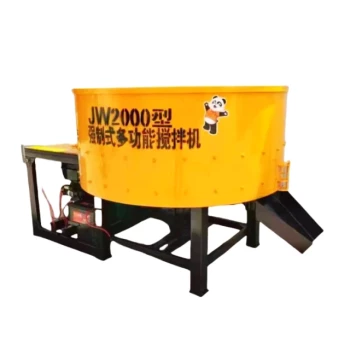Operational efficiency in concrete mixer loading is influenced by multiple factors, including the type of mixer (batch vs. continuous), drum speed and size, labor optimization, and the homogeneity of the concrete mix. Proper selection and management of these factors ensure timely and cost-effective concrete production. Additionally, the efficiency of feeding mechanisms, such as storage devices and valves, plays a critical role in minimizing delays and maintaining workflow continuity.
Key Points Explained:
-
Mixer Type Selection
-
Batch vs. Continuous Mixers:
- Batch mixers are ideal for projects requiring precise control over mix proportions, while continuous mixers suit large-scale operations with consistent material flow.
- Choosing the wrong type can lead to inefficiencies, such as overproduction or delays in meeting demand.
-
Batch vs. Continuous Mixers:
-
Drum Speed and Size Optimization
-
Drum Speed (0–14 RPM):
- Too slow: Inadequate mixing, leading to non-homogeneous concrete.
- Too fast: Increased wear and tear, potential spillage.
-
Drum Capacity (11,530–19,170 liters):
- Undersized drums cause frequent reloading, increasing downtime.
- Oversized drums waste energy and materials if not fully utilized.
-
Drum Speed (0–14 RPM):
-
Labor and Automation Efficiency
- A single operator can manage driving, loading, and dispensing, reducing labor costs.
- Automated mix design input and dispensing minimize human error and speed up operations.
-
Concrete Homogeneity
- Efficiency is measurable through the even distribution of aggregates, cement paste, and admixtures.
- Poor mixing leads to weak spots in structures, requiring rework and increasing costs.
-
Feeding Mechanism Performance
-
Storage Devices & Valves:
- Clogging or valve malfunctions disrupt material flow, slowing loading.
-
Feeding Tool Angles:
- Incorrect angles cause spillage or uneven loading, requiring cleanup and adjustments.
-
Storage Devices & Valves:
By addressing these factors, operators can maximize productivity while minimizing waste and downtime—key considerations for purchasers aiming to optimize equipment ROI.
Summary Table:
| Factor | Impact on Efficiency | Optimization Tips |
|---|---|---|
| Mixer Type | Batch for precision, continuous for large-scale | Match mixer type to project needs |
| Drum Speed & Size | Affects mix quality & energy use | Use 0–14 RPM; select capacity (11,530–19,170L) based on demand |
| Labor & Automation | Reduces errors & downtime | Automate mix design input; train operators |
| Concrete Homogeneity | Ensures structural integrity | Monitor aggregate distribution; adjust mixing time |
| Feeding Mechanisms | Prevents clogs & spillage | Maintain valves; optimize tool angles |
Maximize your concrete production efficiency with GARLWAY’s high-performance mixers! Our concrete batching plants and mixers are engineered for durability, precision, and cost savings—ideal for contractors and construction firms. Contact us today to discuss tailored solutions for your project needs.
Related Products
- Ready Mixer Machine for Construction Ready Mix Machinery
- Commercial Construction Mixer Machine for Soil Cement Mixing Concrete
- Auto Concrete Cement Mixer Machine New
- JDC350 Small Cement Concrete Mortar Mixer
- HZS90 Large Multiquip Concrete Mixers for Construction
People Also Ask
- Can a concrete mixer be used for mortar? Key Considerations for Optimal Mixing
- Is there a difference between a concrete mixer and a mortar mixer? Key Differences Explained
- How to choose the right concrete mix? Key Factors for Strength & Durability
- What factors to consider when selecting type of concrete mixer? Essential Guide for Optimal Performance
- What are the benefits of concrete mixer machine? Boost Efficiency & Quality in Construction



















